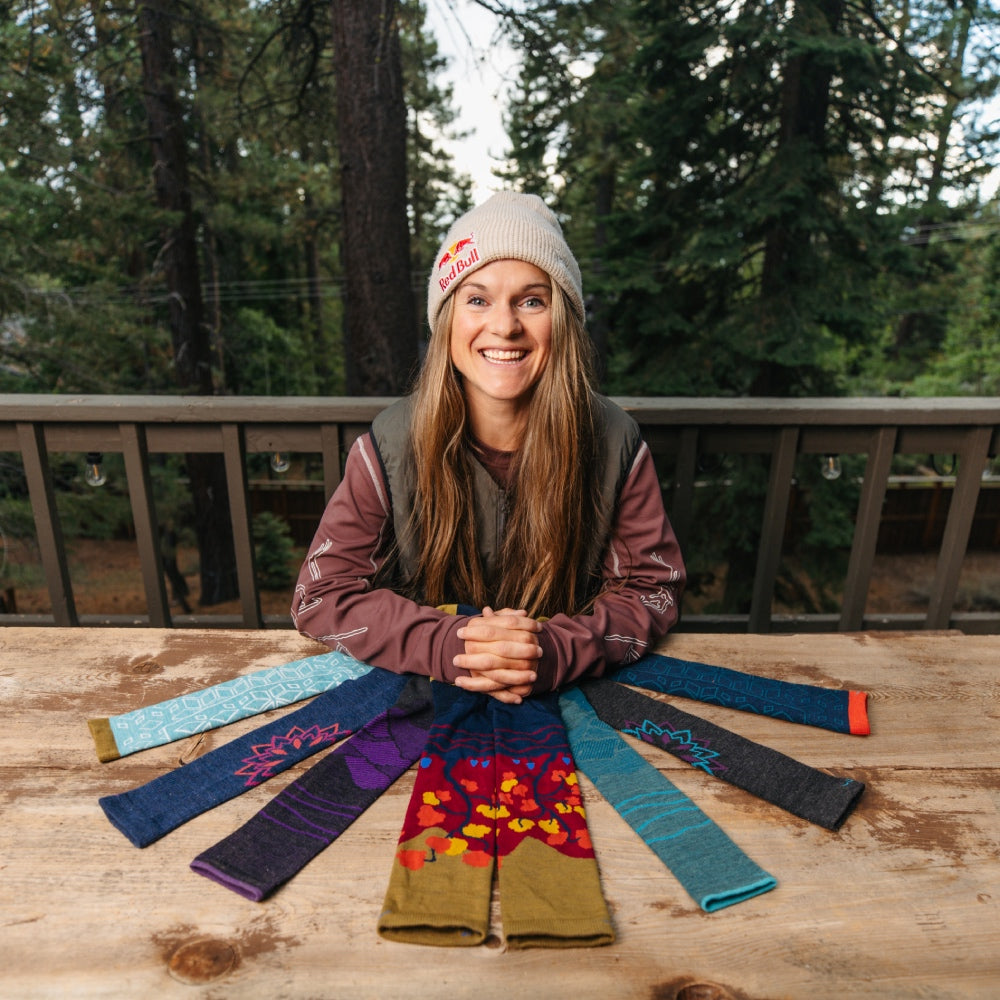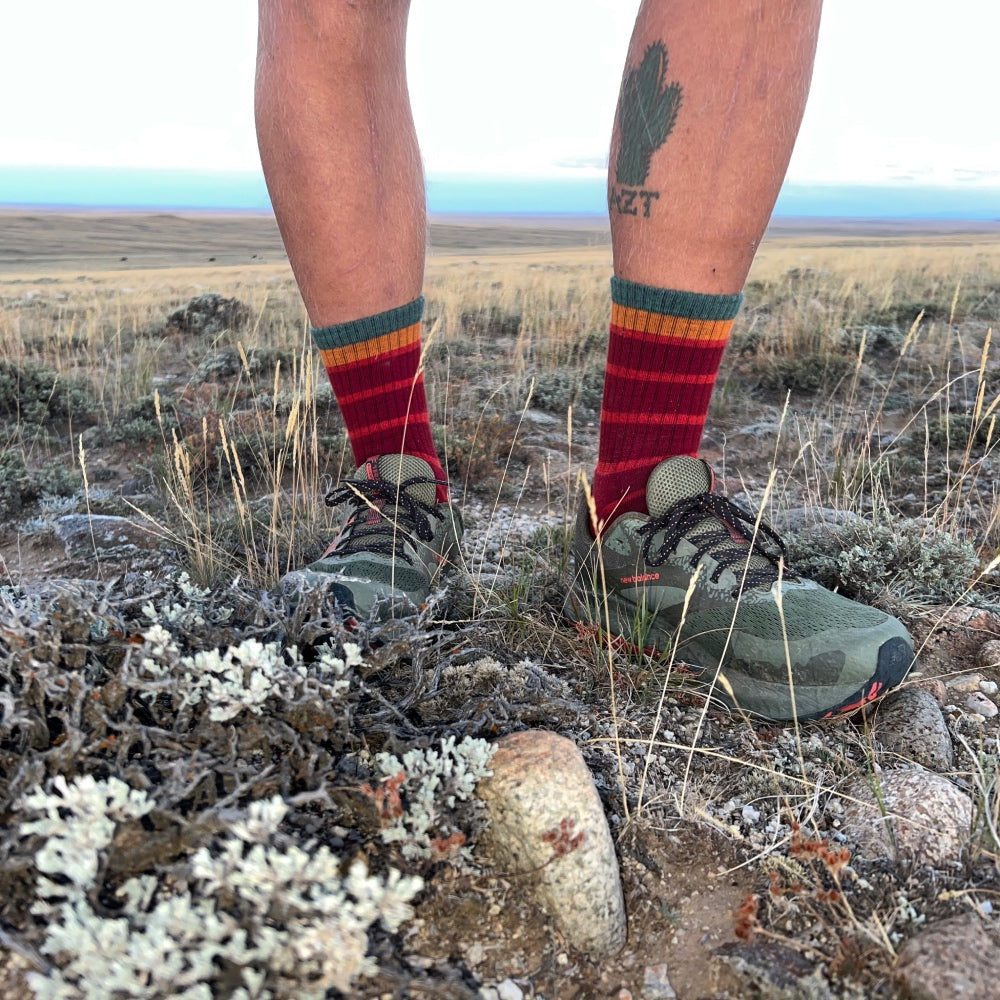The History of Merino Wool, From Flock to Sock

The full-length history of Merino Wool would require several PBS-length installments, a doozy even if full of top-notch historical characters and plot twists (steal a sheep and get beheaded on order of the King, oh my!). So we’ll do our best to condense the tale of how we got from wild sheep shredding the hills to our current and future source of naturally warm and moisture-controlling fabric.
Waaaay Back When...
Wool is one of the oldest raw materials used by humans. The Merino Wool origin story kicks off around 10,000 years ago in Mesopotamia, pretty much the cradle for early civilization. Sheep were among the first animals to be domesticated, and the warmth of their skins and mobility of the flocks allowed agricultural-based civilization to spread beyond the Fertile Crescent.
These early domesticated sheep were primarily raised for meat, milk, and skins, the value of their raw wool became increasingly recognized as time passed.
While it might sound like a long time, trust us, this is things moving fast back then. By the Iron Age, from 3000 to 1000 BC, sheep were being selectively bred for specific traits, and wool was being distributed by the Greeks and Romans throughout what is now called Spain, North Africa and the British Isles. Not too long after, garments made out of woven wool came onto the scene.
1200s: Merino Makes Its Debut
By the Middle Ages, wool and wool trade had made a huge impact around what is now Europe and Asia Minor. To get into it further, we spoke to Kimberly, a Grazing Expert at the University of Vermont’s Center for Sustainable Agriculture. After three decades of raising sheep and now a research career, Kimberly knows her way around wool.
“If you think about the old world,” explains Kimberly, “It was wool, silk, cotton, and flax, which was linen. Those four were the main fibers that could be made into fabric for clothing or any kind of purpose. The thing about wool was that it is very warm, it has natural water repellency, it’s breathable— it was a good all-purpose textile.”

During this time in history, basic commodities like meat and clothing made or broke kingdoms and empires, and sheep and wool products played a major role in expanding trade, and ensuring reliable food supplies. Fittingly, the precursor of what we know to be the Merino sheep breed seems to be as disputed as a jousting match.
Whether it was via new flocks being introduced by North African tribes in the 12th century, or just a long period of selective breeding, Merino Wool soon became Spain’s main export.
For centuries to come, the country held a monopoly on the fine wool which was woven by Italian craftsmen into the soft and supple garments prized by the European aristocracy. Not ones to take things lightly, the Spanish held onto their high-demand economic position fiercely — removal of a sheep from the country was punishable by death.
1800s: William Jarvis & the Vermont Connection
There’s plenty of stitches in this tale we could pull on between the advent of the Merino breed and William Jarvis’s entrance on the stage in the early 1800’s (not quite GOT-level, but plenty of gnarly stuff happened, enough said). But we’re going to zoom in on William, who as Thomas Jefferson’s Consul to Portugal, is the guy who brought Merino Wool — under some duress we’d add — to Vermont. And doesn’t that at least have the ring of an old school crime thriller? Maybe a little?
Here’s how it went down. William already owned a farm in what would become Vermont. And as Kimberly notes, he always had his fellow Americans on his mind, in particular how to better the lives of Vermont farmers. He’d become aware of Merino Wool’s unique qualities and value. It was a short leap then to making the most of things when the Napoleonic wars broke out. All of a sudden, “a lot of the Spanish nobility were in trouble,” says Kimberly, “needed to move out of the country, and they needed cash, fast.” In that time, an animal from the Merino breed of sheep was like cashing in all those hot bitcoins.
With the chaos of invasion bearing down, William bought up what became the foundation of the Merino Wool industry in Vermont and the US. He didn’t start small. According to the Vermont Merino Sheep Breeders Association, over 15,000 Spanish sheep arrived at ports up and down the East Coast.
Early 1800s: The Vermont Merino Wool Boom
Wool was also a hot commodity in the US, where Vermont farmers couldn’t keep up with the demands of a growing woolen industry. Wool had already played a role in sparking the Revolutionary War.
Despite England’s efforts to maintain a stranglehold on clothing exports to their new colonies across the Atlantic, plenty of sheep had been smuggled across, and wool was being produced domestically. The Wool Act of 1699 demanded that the colonies sell all their wool back to England, who then resold it in all areas of the empire, taxing it along the way. You could say the farmers were ticked off. Added to the tea tax, you know where the rest of the story went.
“William thought that the Merino would be a great cash crop for Vermont farmers,” says Kimberly about bringing the breed from Spain to the recently independent state. “And Merino sure was, for a number of years.”
William’s introduction of the Merino couldn’t have been timed better. Two US trade embargos had effectively cut off the import of wool, and suddenly the value of domestic wool, especially Vermont Merino Wool, shot through the roof. Around the state, farmers abandoned their crops and cut down thousands of acres of trees to make room for the sheep.
“Most of Vermont is boney, not much soil,” explains Kimberly. “Sheep were an animal that easily grazes steep hillsides, eats vegetation that doesn’t have to be the finest, and it still produces wool and meat. It was a versatile animal; small, compact, easy to move around, and it produced a great fiber. There was a great deal of wealth here for such hard land.”
The market responded and drove the frenzy into a boom. Textile manufacturers were willing to pay nearly 100% more for Merino Wool than normal wool, and Merino rams sold for as high as $1,500 each, compared to $2.00 for a common sheep. It’s not hard to see why farmers went all in. Kimberly called it a golden era, suggesting it was one of the largest revenue drivers the state would see until the ski industry came along. But like all booms, it ended in a bust.
Mid-1800s to Present: Sheep That Shaped the State
An end on protective wool tariffs, the railroad being completed to the west coast, and introduction of more global trade saw the inflated valuation of Vermont Merino Wool pop. The breed, more suited to drier climates, was much easier and cost-effective to raise out west, and later, in places like New Zealand and Australia. After Merino prices plummeted, a second wave brought increased demand in the form of wool needed for Civil War uniforms. But soon this was yet another page in the history books, and the sheep that had been a Vermont staple became pretty scant in the picture.
What’s left is a pretty big footprint. You can see it in the massive stone houses and big farms were built on Merino Wool money, and the mill sites around the state where seasonal water run off was used to process wool. Large land tracts cleared for sheep were turned to pasture for dairy cattle, an industry that took off once trains with refrigeration could transport Vermont milk and butter products to the Boston and New York markets.
Many of the trees and fields have grown back in since then, and you’d have to dig behind that leafy curtain of secessional growth for evidence of Vermont’s faded status as a leading “sheep state.” In a significant way though, the ubiquitous image of black and white Holstein cows grazing against a green mountain backdrop started with much smaller animals. That iconography began with a humble flock of sheep, nibbling away at the hillsides, farmers herding and shearing them for their fine Merino Wool.
Sheared a Little too Close for Comfort
It’s hard not to imagine William Jarvis’ reaction to the mechanization of the Industrial Revolution. While William’s adopted home state was, ahem, shorn of its Merino legacy, steam engines were powering shearing machines, heating water for wool washing and scouring in factories, and even powering printing presses for books on farming and breeding practices. Merino Wool benefited from all this, allowing its long-prized performance qualities to become even more accessible.

But as a wise Greek philosopher noted, “You can’t step in the same river twice,” aka, change is the only constant. Especially in the 21st century, wool was in for another gut-twisting descent. Cotton was a competitive fabric commodity that saw a massive come up through mechanization and industrialization. And unlike wool, there was no shearing or flocks to be tended. Compared to innovations in wool processing, cotton was way easier to optimize, and from there, its price became comparatively cheaper and cheaper. Yes, despite being wet, soggy, all that.
After World War II came the advent of polyester and spandex. From there, the use of synthetic, polymer-based fabrics to develop everyday garments and performance wear took a real bite out of the wool market, a turn that, well, seemed like it could put Merino Wool out to pasture.
Modern Merino Right Under... Er, Around Your Feet
Things were indeed looking dicey for wool by the turn of the century. Yet, as wise as the Greek’s were, maybe all those linen robes made them biased. Or, they just didn’t have the benefit of an extra few thousand years of experience. If they had, maybe they’d have noted that the original go-to for wearable warmth was just on a minor detour. Wool is now on a resurgence. Here’s how the latest thread, from the same Merino tale, is being told right here at The Mill.

Fine-tune that time machine to 2004, and you’ll find a Vermont-based sock maker launching a new brand, Darn Tough, featuring Merino Wool, a risky play given the sock market, not to mention the dip in public awareness about wool clothes at the time.
Envisioned as the “all weather performance sock,” Merino Wool was chosen for being the most durable, versatile, and premium option available for customers stepping out into the toughest of conditions. Safe to say the fabric has lived up to that standard.

“I’m just so excited. It’s great to see these companies make value added products out of wool again,” says Kimberly. “The push is really coming from the performance of the fiber itself. No man-made substitute comes close to what wool can do, especially if you work and play in the outdoors and your body temp changes.”
Helping Move Merino into the Future
Since 2004, Darn Tough has been on a quest to optimize Merino Wool socks for hiking, running, skiing, work, and more — comfort and quality that sock wearers are definitely learning to love above and beyond synthetic substitutes. With performance on lock, the latest chapter revolves around environmental and climate science, which has been warning of the impact of fossil-fuel products for quite a while.
“Global awareness of the climate crisis has awakened many consumers to the reality that petroleum-based plastic synthetic fibers may be cheaper to manufacture, right now,” says Jenny, Darn Tough Product Designer, “but synthetics are creating pollution that cannot biodegrade, and have immediate and deferred costs to our health and planet. This has led to a renewed appreciation for durable and performance natural fibers like Merino Wool that are more sustainable.”

What’s the future for Merino Wool products look like? Jenny points to climate change as being one of many drivers that will “shift thinking to embrace, seek, and purchase natural and biodegradable products.”
Like all things at Darn Tough, we’re applying the principle of “We have yet to make our best sock” to the wool itself. Yes, wool has major benefits over synthetics, but it doesn’t come without its own impacts also. The future of Merino Wool lies in addressing these, for the good of the planet, and the industry itself.
That’s why Darn Tough is working to ensure all of its wool procurement follows the guidelines of the Responsible Wool Standard. The RWS provides transparency throughout the supply chain— ensuring animal welfare, responsible land stewardship and sustainable wool processing. In turn, the hope is that we can provide you a sock that doesn’t just live up to the fantastic history of wool, but offers a better tomorrow for all of us.







